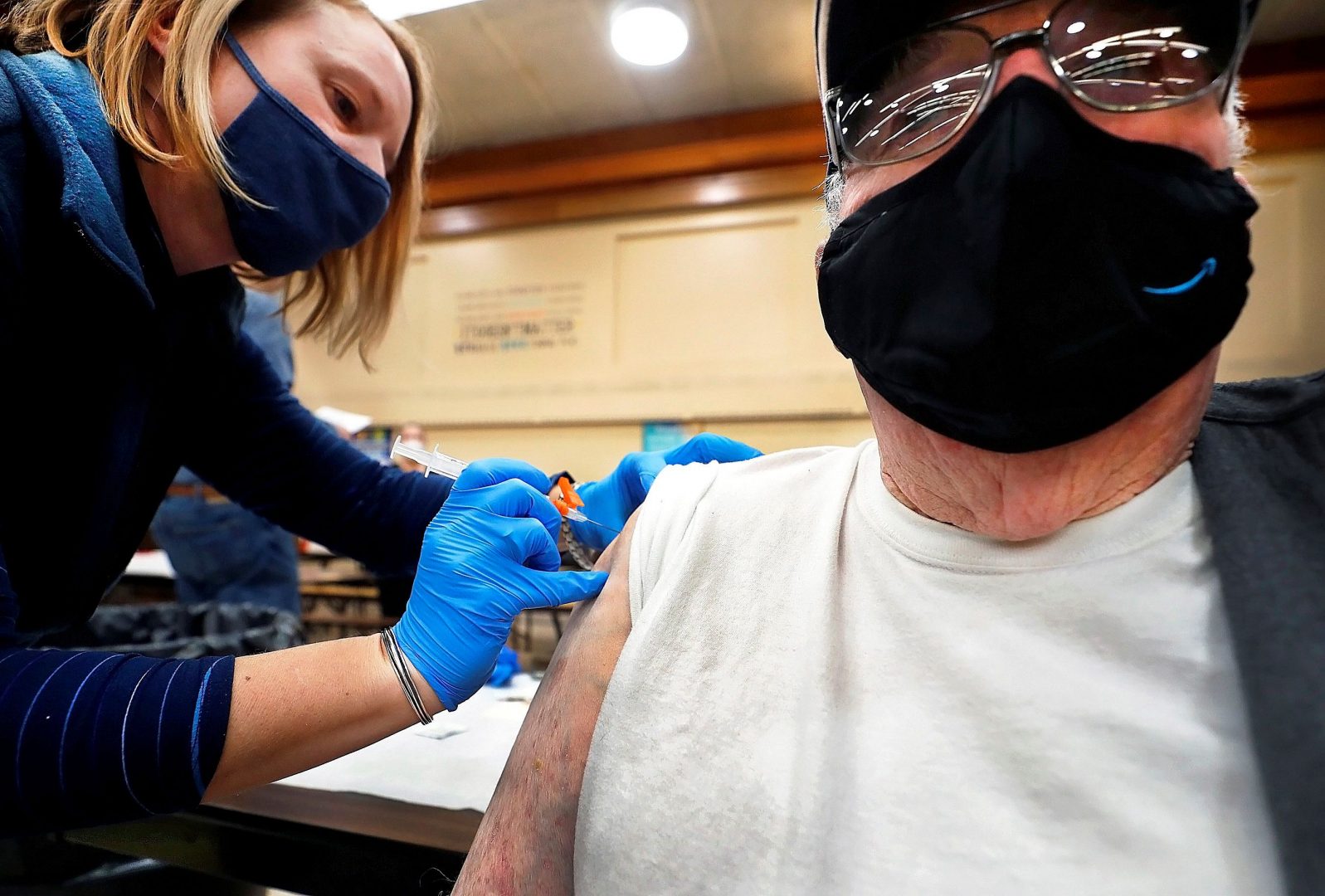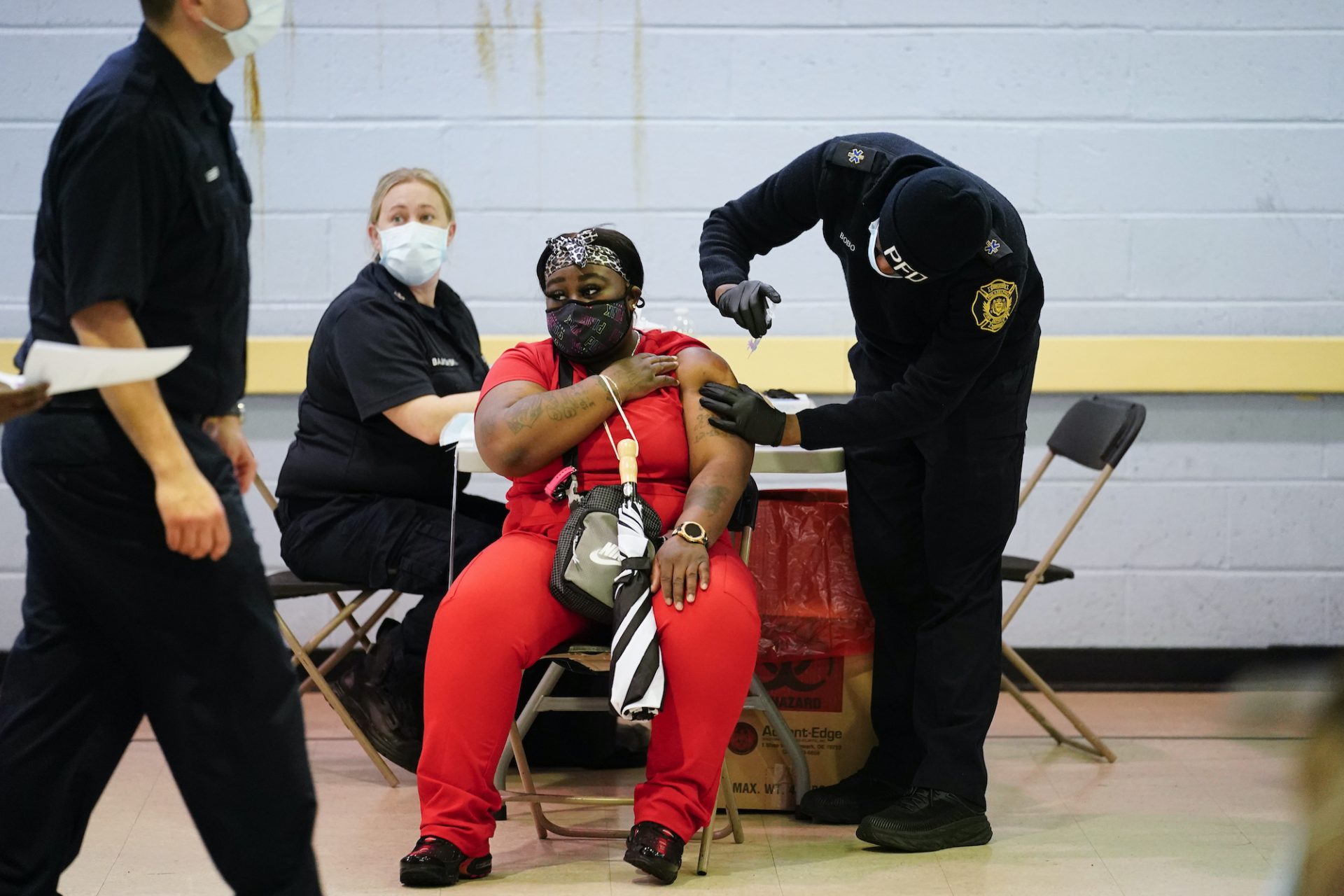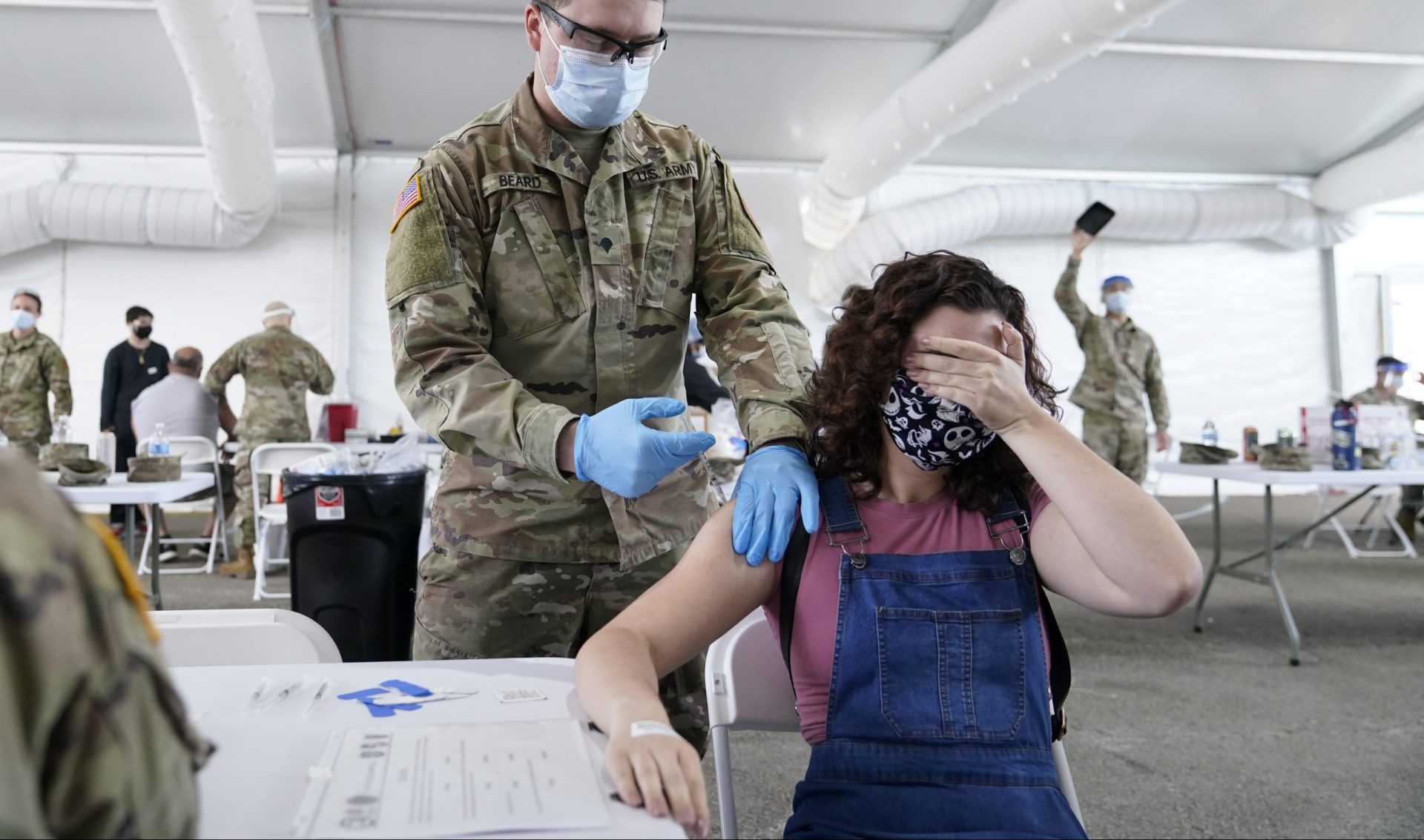
One provider who reported a high number of spoiled doses cited a late shipment from the state and a lack of demand.
Fred Adams / Spotlight PA

One provider who reported a high number of spoiled doses cited a late shipment from the state and a lack of demand.
Fred Adams / Spotlight PA

Fred Adams / Spotlight PA
One provider who reported a high number of spoiled doses cited a late shipment from the state and a lack of demand.
(Pittsburgh) — Maureen Lichtveld’s nearly 40 years in environmental public health — from her home country of Suriname, to the U.S. government, to the Hurricane Katrina-devastated Gulf Coast and, finally, to Pittsburgh this year — has focused on a central principle: how to prepare for the next big crisis.
Her “aha” moment came early, in her mid-20s as she worked to increase vaccination rates among children in the Amazon jungle. By training more health care workers and promoting vaccine effectiveness more widely, she helped send those rates from 5% to 95% in just three years, she said.
“I could not, as an individual, vaccinate all those thousands of kids,” said Dr. Lichtveld, who took over as dean of the University of Pittsburgh Graduate School of Public Health on Jan. 1. The effort called for a public health solution that focused on the whole community, its culture, its environmental factors, long-standing inequities and health impacts.
Taking a broader view has become central strategy to the federal government’s efforts to bolster the nation’s defenses after the COVID-19 pandemic exposed vulnerabilities at the highest levels.

Matt Rourke / AP Photo
A member of the Philadelphia Fire Department administers the Johnson & Johnson COVID-19 vaccine to a woman at a vaccination site setup at a Salvation Army location in Philadelphia, Friday, March 26, 2021.
“The COVID-19 pandemic, as the limited coverage for childhood vaccinations back then, is a public health problem, requiring public health strategies of preparedness, vaccination and control,” said Dr. Lichtveld, who is aiming to position the Pittsburgh university — already an engine of health research — at the forefront of this deeper bureaucratic soul-searching that experts say is long overdue.
The worst health catastrophe in a century has prompted a renewed focus on research and innovation.
More than once, Pittsburgh has answered the call to supply expertise and research to help the nation deal with its really big problems. A little over a decade ago, Pittsburgh health system UPMC hosted dozens of government officials and private sector experts for a debate around creating a new federal agency meant to bring new vaccines to market.
That agency — the Biomedical Advanced Research and Development Authority — would eventually play a role in creating a public-private partnership that led to one of the vaccines now helping Americans fend off COVID-19.
Although U.S. officials have celebrated some breakthrough successes — including moving at breakneck speed to produce safe and effective COVID-19 vaccines in less than a year — the virus’s ability to capitalize on some of the government’s long-standing weaknesses may have exacerbated the pandemic that has killed nearly 600,000 Americans.
Those weaknesses include:
— a chronically underfunded public health system,
— an uneasy reliance on a messy global supply chain,
— a lack of communication between agencies, and
— bungled foresight planning for future pathogens, what former Secretary of Defense Donald Rumsfeld famously called the “unknown unknowns.”
So what now? The response from President Joe Biden and lawmakers has been to launch the kind of patriotic push for federal investment in science and technology not seen since the Space Race of the 1960s.
From 1960 to 1973, the U.S. spent some $28 billion — $283 billion in today’s dollars — on the space program to send a crew of astronauts to the moon, according to the Planetary Society’s analysis of original budget documents at the NASA Historical Reference Collection. The Space Race helped to boost total R&D spending to a peak of 11.7% of all federal spending in 1965, up from 2.8% a decade earlier.

Lynne Sladky / AP Photo
In this April 5, 2021, file photo, Leanne Montenegro, 21, covers her eyes as she doesn’t like the sight of needles, while she receives the Pfizer COVID-19 vaccine at a FEMA vaccination center at Miami Dade College in Miami. Nearly half of new coronavirus infections nationwide are in just five states, including Florida — a situation that puts pressure on the federal government to consider changing how it distributes vaccines by sending more doses to hot spots.
And now, at this moment in history, the push to do better in the future seeks to tap into that stunning moment of past success. Research and development, Washington leaders say, will allow the U.S. to compete with 21-century adversaries like China, combat climate change while growing jobs and guard against supply shocks halfway around the world.
The big ideas now coming out of D.C. could send more dollars to Western Pennsylvania in search of answers.
One bipartisan proposal in Congress pledges $100 billion for “strategically important” advances in science and $10 billion for regional tech hubs like Pittsburgh. Mr. Biden’s infrastructure plan calls for investing $50 billion in the National Science Foundation, $40 billion to upgrade facilities at federal laboratories across the country, and $30 billion in funding for research and development with a focus on neglected regions.
Mr. Biden has proposed $6.5 billion to create a new advanced research agency for health care, ARPA-H, modeled on a similar program in the Energy Department’s ARPA-E and on the Defense Department’s DARPA, which doles out money to Carnegie Mellon University among other places.
But it will take more than just throwing money at the problem.
Can U.S. leaders, adept at channeling massive resources to eradicate an existing threat, embrace futurist thinking to plan for the next pandemic?
“This is a window of opportunity,” said Anita Cicero, deputy director at the Johns Hopkins Center for Health Security and part of a group of experts laying the groundwork for a possible federal COVID-19 commission.
“The whole country and our leaders and the world understand that we were not well prepared,” Ms. Cicero said.
The U.S. Department of the Future
Anticipating future threats has always been a blind spot of the federal government, said Amy Webb, founder of Future Today Institute, a New York-based forecasting and strategy firm.
Decision-makers in Washington too often work in their silos across hulking federal buildings, she said, and the political leadership falls victim to a myopic focus on short-term election cycles and the rising two-party polarization.
Ms. Webb gained attention for her 2016 essay published in Politico that called for the creation of a U.S. Department of the Future. In 2019, she followed up with recommendations for a National Strategic Foresight Office, which “is needed now more than ever,” she said in a recent interview.
The political strife has hurt funding. In April 2020 — not two months into the pandemic shutdowns — a Goldman Sachs study on federal science investment issued a stark statistic: Federal R&D spending equaled 0.6% of U.S. gross domestic product in the 2019 fiscal year.
That’s the lowest portion in more than 60 years, since before the race for the moon.
Funding for the National Institutes of Health — which doles out grant money for sometimes high-risk, high-reward research at universities like Pitt — has been essentially flat since 2004, the report found.
A less obvious problem lies in the tangled web of congressional appropriations subcommittees and federal agencies tasked with issuing dollars to targeted goals.
Sudip Parikh, CEO of the American Association for the Advancement of Science, estimated at least six different federal agencies are seeking a cure for cancer and as many as 15 agencies manage pieces of climate change research.
From 2001 to 2009, Mr. Parikh served as science advisor on Senate Appropriations Committee. He was responsible, working with former Sen. Arlen Specter, R-Pa., for negotiating budgets for the National Institutes of Health, Centers for Disease Control and Prevention, and other scientific and health agencies.
“For the really big existential questions,” he said, “the coordination isn’t there across all of government … And we need that.”
Moonshot goals
Search engine giant Google dangled $30 million for a team to send a rover to the moon. A Portuguese organization offered up more than $500,000 for research that monitors plastic litter on a global scale, using artificial intelligence and satellite data.
And the Center for American Progress and the Thomas B. Fordham Institute hosted a Shark Tank-style competition that awarded $10,000 to educators to improve classroom learning.
Deep-pocketed investors and foundations have increasingly funded prizes and grant funding to spur people to achieve audacious goals, said Shawn Dubravac, an economist and self-described futurist with IPC, an Illinois-based trade organization that studies supply chains.
But federal agencies, particularly in the health space, must take a more active role in funding strategic ventures too risky or costly for private companies, Mr. Dubravac said.
“It’s always a challenge when you’re trying to produce something for the current period but also build something for much further down the road,” he said.
That’s one reason that planners look back with awe to the space race.
“We set audacious goals for landing a man on the moon,” Mr. Dubravac added. Today, the country’s vision is “not mapped out as much as it should be — what the timeline is and how we’ll get there.”
Pittsburgh and BARDA
In the health space, federal efforts to boost research have gone through Pittsburgh before.
In January 2007, four dozen government officials, health policy experts, infectious disease researchers and drug industry representatives gathered at a UPMC-hosted event in Pittsburgh to debate a new federal agency that would bring to market new vaccines and therapeutics.
The participants hoped the agency — the Biomedical Advanced Research and Development Authority — would address emerging threats by funding ventures through the costliest advanced research phase. It was a recurring problem that many ventures would get NIH money for research and then run out of money during clinical trials and development.
“There was a lot of excitement about this,” recalled Ms. Cicero, the Johns Hopkins deputy director who represented a consortium of drug companies at that Pittsburgh meeting.
The Biomedical Advanced Research and Development Authority went on to aid 59 federally approved products and create more than 500 public-private partnerships, including the Johnson & Johnson COVID-19 vaccine.
But Ms. Cicero said the research authority, too, has had too narrow of a focus.
Following the pandemic, she said, the agency should expand its focus from specific pathogens — known as “one bug, one drug” strategy — and instead attack broader viral families that could pose a threat.
Competing for NIH money
Dr. Lichtveld, the Pitt dean, has spent her career trying to improve the country’s defenses.
During her 18 years at the Centers for Disease Control and Prevention, she started a program that established centers for public health preparedness at 38 schools nationwide, including one at Pitt.
Those centers, which were later defunded, aimed to improve the ability of local public health systems to respond to infectious disease outbreaks, biological attacks or other catastrophes.
In 2003, she was involved in discussions, following the 9/11 terrorist attacks, to create a repository of drugs, vaccines and medical supplies known as the Strategic National Stockpile. The stockpile — spread across 12 classified locations across the country — likely resembles a warehouse-sized drug store chain: shelves of pharmaceuticals and supplies sitting on shelves that can reach five stories high.
When she took a job at Tulane University in New Orleans in 2005, three weeks before Hurricane Katrina, she saw the stockpile in action, delivering tuberculosis drugs and other emergency medications to people in need.
She wants to grow that foresight capacity at Pitt — and by extension, the country.
The University of Pittsburgh has received $5.3 billion in NIH money since 2010, according to the agency’s grant data. In 2020, the school received 1,158 awards totaling $570 million, the ninth-most of any organization in the country. (Mr. Biden’s budget proposal to Congress last month boosts the NIH budget by 21% to $51 billion.)
Dr. Lichtveld’s administrative oversight at Pitt Public Health spans seven academic departments, 640 students, 160 faculty and 320 support staff.
“It excites me to have all the assets in place,” she said. “Federal funding is key for our research, but it’s also key in helping translate our research into action.”
To that end, she envisions Pitt’s campus in Oakland, which connects public health researchers with those steeped in other disciplines like public policy and economics, as a place that can build cutting-edge modeling to help predict how future pandemics — the next COVID-19 or SARS — could affect the restaurants on Fifth Avenue, the paychecks of workers Downtown and the health of people living in Squirrel Hill.
“Just like we need to look at a body as holistic systems of organs, we need to look at the community as an entity,” she said.

Get insights into WITF’s newsroom and an invitation to join in the pursuit of trustworthy journalism.
The days of journalism’s one-way street of simply producing stories for the public have long been over. Now, it’s time to find better ways to interact with you and ensure we meet your high standards of what a credible media organization should be.